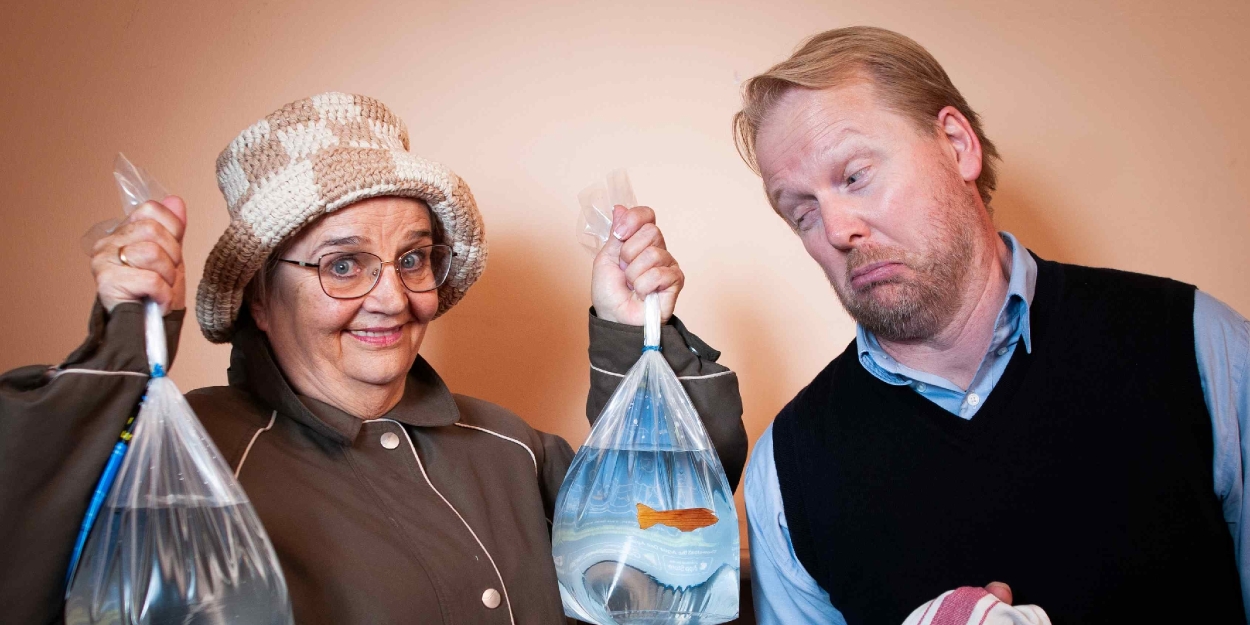Review: LIFE WITHOUT ME at Stirling Community Theatre
Absurdist humour in a hotel foyer.

Reviewed by Barry Lenny, Friday 28th March 2025.
Megan Dansie has directed Daniel Keene's existential 2010 play, Life Without Me, for the Stirling Players. It all takes place in the foyer of a decaying hotel, without a kitchen, run by Nigel and owned by his mother, Mrs Spence. Three individual guests and one couple arrive during the course of a couple of days. They are lost souls who philosophically wonder who they are, and why they are here, They seek to know their place in the world.
To quote the playwright, "The characters gather in the hotel’s lobby although not all are guests. They meet by accident and the conceit is a little like (The Eagles’ hit) Hotel California. It is difficult to leave and certain things develop because they are stuck together” (Daniel Keene, 2010)
The first to arrive, blown in through the doors by a powerful wind, is John, played by Steve Marvanek, who finds himself struggling against the bizarre demands of Nigel, played by Brad Martin, when he tries to register as a guest and book a room, without having a prior reservation. John claims that he has been trying to leave the city for three days, but continually ends up back where he started, finding no way out.
Nigel is more concerned about the fact that there is no pen for John to sign the register and that signing in pencil is inconclusive. He seems intent on putting John off of every room in the hotel. In his obstructive approach to customer relations, driving John to distraction, he makes Basil Fawlty look good.
The lift is out of order and has a mind of its own, there are no fish in the fish tank, and Nigel burns the toast. Absurdist theatre is alive and well. There is a circularity to the dialogue that reflects the various guests trying to leave, but going around in circles and ending up back at the hotel.
Aside from an occasional lack of pace, the opening scene tells the audience that Dansie has cast some impressive performers. Martin and Marvanek set up some fine interplay, with Nigel goading John who rises to the bait, his anger and frustration increasing to the point where he is about to leave, before Nigel relents. These two have a big job to do, not only in establishing their two quirky characters, but in setting up the premise for what is to follow, and explaining much about the hotel.
Widower, Roy Williams, played by Brant Eustice, is a travelling salesman who insists that he has an appointment with the owner of the hotel to try to sell her new linen. Roy and John get into a strangely rambling conversation over their different types of faces, when John first thinks that he might have known Roy. Nigel, ever the difficult concierge, explains that he cannot possibly have an appointment that day, because it is not the day of the week that the owner, his mother, comes to the hotel. Eustice turns in another of those carefully crafted, captivating performances that we have come to expect of him.
Michelle Hrvatin plays spinster, Alice Jarvie, who is already living in a room, temporarily, as her new home is not yet ready for her to move in. She steps out of the lift complaining that the huge pot plant that she is carrying is making her ill, dumping it on top of Roy’s suitcases full of samples. She complains about the plant and he complains about it being on his cases. They suddenly recognise one another, then realise that they are strangers who just happen to have once, thirty years before, had friends named Alice and Roy. Later, together on her balcony, they become closer as they discuss the people that they knew. Hrvatin gives a sensitive performance as the lonely woman, growing as she makes a connection with Roy.
A young married couple who have known each other since primary school, Tom and Ellen, played by Matthew Chapman and Leah Lowe, are in a stagnated relationship. He hopes that a little role-playing will set everything to right. He is wrong. Chapman and Lowe work very well together as a couple who, perhaps, should never really have been together at all, and seem to have just drifted into that situation. They clearly bring out the differences between their characters.
Sue Wylie plays the rather vague, widowed Mrs. Spence, and steals every scene. She arrives with plastic bags containing goldfish and she and Nigel discuss fish for an extended period, before then reminiscing about her late husband. At moments lucid, Mrs. Spence lapses into forgetting that her husband has died. Dithery, and not quite with all that is happening around her, it is an actor’s dream role, and Wylie, in a standout performance, doesn’t waste a single word of her dialogue, adding a superb physicality to match.
Erik Straut’s set is a spacious foyer, flanked on either side by small balconies belonging to the upstairs rooms occupied by Alice, on one side, and Tom and Ellen, on the other. There is a small reception desk with a door behind it to the office, an exit to the stairs, the lift doors, the main doors, and an array of furniture. Lamps are suspended from the ceiling; the one over the desk initially has a dead light bulb that Nigel has to replace. It is all very shabby and does not appear to have been maintained for a long time. Richard Parkhill’s lighting design amplifies the seediness. Sean Smith is responsible for the many sound effects, from raging storms to squeaky lift doors.
There are many ways to interpret this play and, no doubt, there will be discussions by audience members for some time after as to what metaphors are in play, and what meanings the playwright hopes that we will take away from it. You will need to decide for yourself after you have seen this fascinating work.
Photography, Daniel Salmond.
Reader Reviews

Videos

